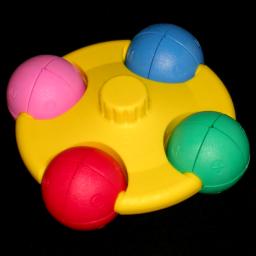



There are several puzzles called Ufo, but this one is made by Netblock. It consists of a disc which is split into two layers which can rotate about the central axis. Spaced evenly along the rim of the disc are 3 spheres of different colours. These are split into octants, so that when the layers of the disc are turned, one half of each sphere (4 pieces) travels with each layer. The spheres can also rotate in two halves about an axis along the disc edge. Although this puzzle is hard to describe, it is fairly easy to solve.
An earlier version is called King Ring, or Sando Ring. This is much larger, uses bright colours, and has four spheres. It looks very much like a toddler's toy.
The Ufo was patented on 13 May 1997 by Wai K. Chan, US 5,628,512. The King Ring was patented on 21 March 1996 by Zoltan Pataki, Istvan Varadi, and Attila Kovacs, WO 96/08297.
The first restriction means that there are at most 12!2 / 4!6 = 1,200,622,500 possible positions. The second restriction means that the real number of positions is about 1/6th of that number because the puzzle can be held in 6 different ways (due to the three-fold symmetry around the centre, and because it can be turned over). As some positions are themselves symmetric, the exact number can best be calculated with Burnside's Lemma, and this gives 200,121,075 positions.
If you also consider the three colours to be equivalent, then the number is reduced by a further factor of about 6 because the colours can be permuted in 3!=6 ways and those positions are all now considered to be the same. Burnside's Lemma shows that the exact number of positions is then 33,362,904. This is small enough for God's Algorithm to be calculated by computer, resulting in the following table. It shows that at most 15 moves are needed, or 16 moves if half turns count as 2 moves.
| Face turn metric | ||||||||||||||||||
|---|---|---|---|---|---|---|---|---|---|---|---|---|---|---|---|---|---|---|
| 0 | 1 | 2 | 3 | 4 | 5 | 6 | 7 | 8 | 9 | 10 | 11 | 12 | 13 | 14 | 15 | Total | ||
| Q u a r t e r t u r n m e t r i c | 0 | 1 | 1 | |||||||||||||||
| 1 | 2 | 2 | ||||||||||||||||
| 2 | 4 | 4 | ||||||||||||||||
| 3 | 2 | 34 | 36 | |||||||||||||||
| 4 | 24 | 164 | 188 | |||||||||||||||
| 5 | 8 | 180 | 868 | 1056 | ||||||||||||||
| 6 | 67 | 1298 | 4458 | 5823 | ||||||||||||||
| 7 | 4 | 574 | 8234 | 20870 | 29682 | |||||||||||||
| 8 | 56 | 4996 | 46900 | 89452 | 141404 | |||||||||||||
| 9 | 1024 | 34268 | 229076 | 337892 | 602260 | |||||||||||||
| 10 | 48 | 8328 | 182444 | 956972 | 1056030 | 2203822 | ||||||||||||
| 11 | 391 | 37452 | 735476 | 3073204 | 2412533 | 6259056 | ||||||||||||
| 12 | 1052 | 116878 | 1932820 | 6144988 | 3345129 | 11540867 | ||||||||||||
| 13 | 3 | 2468 | 189408 | 2307000 | 5372691 | 2134352 | 10005922 | |||||||||||
| 14 | 1564 | 77394 | 679615 | 1359786 | 378192 | 2496551 | ||||||||||||
| 15 | 102 | 2646 | 24576 | 42478 | 6266 | 76068 | ||||||||||||
| 16 | 14 | 76 | 72 | 162 | ||||||||||||||
| Total | 1 | 2 | 6 | 66 | 415 | 2796 | 18760 | 110757 | 539479 | 2149686 | 6253026 | 10942017 | 9400081 | 3518728 | 420746 | 6338 | 33362904 | |
King Ring / Sando Ring: There are 32 pieces, 8 of each colour. Using the same reasoning as above, we get 16!2 / 4!8 = 3,976,941,969,000,000 positions. The real number of positions is about 1/8 of this, and the exact number given by the Burnside Lemma is 497,117,746,919,592.
Phase 1: Solve the front ball.
In this phase the front ball will be solved. I will assume you will make
it red, though you could of course solve a different colour first.
Phase 2: Solve the remaining balls.